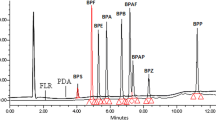Abstract
A characteristic peak of fluorescent whitening agents (FWAs) was detected by fluorescence excitation spectrum (FES) measurement of river water samples. The main causative chemical was 4,4’-bis(2-sulfostyryl)-biphenyl (DSBP), which is commonly added to household detergents in Japan. As the fluorescence of DSBP overlaps with that of fulvic-like organic matter in the spectral fluorescent signatures, DSBP concentration was determined by the newly proposed calculation method, which uses fluorescence intensity at three excitation wavelengths of 320, 345 and 360 nm at emission wavelength of 430 nm for baseline correction. The concentration of DSBP calculated using this method showed strong correlation (correlation coefficient: r = 0.992) with that obtained by high-performance liquid chromatography analysis. The concentrations of DSBP detected in river water samples were 0.28 to 1.84 μg l−1, with high concentrations observed at the stations with relatively high flow rates of upstream sources of treated domestic wastewater and untreated gray water (domestic wastewater excluding flush toilet wastewater).
It was proved that the concentration of DSBP in river water is useful for giving rough estimation of the magnitude of domestic wastewater contamination in river water.







Similar content being viewed by others
References
Abe, A., Tanaka, K., Fukaya, K., & Takeshita, S. (1983). Determination of fluorescent whitening agents in river water and sediment by high pressure liquid chromatography. Suishitsu Odaku Kenkyu, 6(6), 399–405.
Baker, A. (2001). Fluorescence excitation–emission matrix characterization of some sewage-impacted rivers. Environmental Science and Technology, 35(5), 948–953.
Baker, A. (2002a). Fluorescence properties of some farm wastes: Implications for water quality monitoring. Water Research, 36, 189–195.
Baker, A. (2002b). Fluorescence excitation–emission matrix characterization of river waters impacted by a tissue mill effluent. Environmental Science and Technology, 36(7), 1377–1382.
Canonica, S., Kramer, J. B., Reiss, D., & Gygax, H. (1997). Photoisomerization kinetics of stilbene-type fluorescent whitening agents. Environmental Science and Technology, 31(6), 1754–1760.
Coble, P. G. (1996). Characterization of marine and terrestrial DOM in seawater using excitation–emission matrix spectroscopy. Marine Chemistry, 51, 325–346.
Coble, P. G., Green, S. A., Blough, N. V., & Gagosian, R. B. (1990). Characterization of dissolved organic matter in the Black Sea by fluorescence spectroscopy. Nature, 348(29), 432–435.
Hayashi, Y., Managaki, S., & Takada, H. (2002). Fluorescent whitening agents in Tokyo Bay and adjacent rivers: Their application as anthropogenic molecular markers in coastal environments. Environmental Science and Technology, 36(16), 3556–3563.
Kramer, J. B., Canonica, S., Hoigné, J., & Kaschig, J. (1996). Degradation of fluorescent whitening agents in sunlit natural waters. Environmental Science and Technology, 30(7), 2227–2234.
Marhaba, T. F., Van, D., & Lippincott, R. L. (2000). Rapid identification of dissolved organic matter fractions in water by spectral fluorescent signatures. Water Research, 34(14), 3543–3550.
McKnight, D. M., Boyer, E. W., Westerhoff, P. K., Doran, P. T., Kulbe, T., & Andersen, D. T. (2001). Spectrofluorometric characterization of dissolved organic matter for indication of precursor organic material and aromaticity. Limnology and Oceanography, 46(1), 38–48.
Poiger, T., Field, J. A., Field, T. M., & Giger, W. (1996). Occurrence of fluorescent whitening agents in sewage and river water determined by solid-phase extraction and high-performance liquid chromatography. Environmental Science and Technology, 30 (7), 2220–2226.
Poiger, T., Field, J. A., Field, T. M., Siegrist, H., & Giger, W. (1998). Behavior of fluorescent whitening agents during sewage treatment. Water Research, 32(6), 1939–1947.
Stoll, J. M. A., & Giger, W. (1997). Determination of detergent-derived fluorescent whitening agent isomers in lake sediments and surface waters by liquid chromatography. Analytical Chemistry, 69(13), 2594–2599.
Stoll, J. M. A., & Giger, W. (1998). Mass balance for detergent-derived fluorescent whitening agents in surface waters of Switzerland. Water Research, 32(7), 2041–2050.
Takahashi, M., Kaiga, N., & Kawamura, K. (2004). Fluorescence analysis for measurement of dissolved organic matter in environmental water. Journal of Japan Society on Water Environment, 27(11), 721–726.
Takahashi, M., Kaiga, N., & Sudo, R. (2003). Fluorescence excitation spectrometric analysis and evalation of fulvic-like organic matter in river water. Journal of Japan Society on Water Environment, 26(3), 153–158.
Author information
Authors and Affiliations
Corresponding author
Rights and permissions
About this article
Cite this article
Takahashi, M., Kawamura, K. Simple Measurement of 4,4’-bis(2-sulfostyryl)-biphenyl in River Water by Fluorescence Analysis and Its Application as an Indicator of Domestic Wastewater Contamination. Water Air Soil Pollut 180, 39–49 (2007). https://doi.org/10.1007/s11270-006-9248-1
Received:
Accepted:
Published:
Issue Date:
DOI: https://doi.org/10.1007/s11270-006-9248-1




